Last night, I had the opportunity to work with these really interesting new needles on the market called Spiral Eye Needles. The point behind them (no pun intended!) is that you don’t have to “thread” them the same way you do regular needles. So let’s take a look at the Spiral Eye needle and see what it’s all about.
At the time this article was written, there were only two sizes of Spiral Eye needles – SE1 and SE2 – available. However, now there’s a whole slew of sizes and types, including fine sizes for hand embroidery, Spiral Eye chenille needles, and Spiral Eye tapestry needles. Here’s a size chart for the different Spiral Eye needles, so you can see what types are now available.
In this article, I’m reviewing the SE1 and the SE2. I’ve tried the finer Spiral Eye needles, too, and they work well!
SE1 is apparently suited for hand sewing and is similar to a sharp, size 4, and shaft-wise, equivalent to about a size 22 tapestry needle. SE2 is similar to a size 6 embroidery (or crewel) needle.
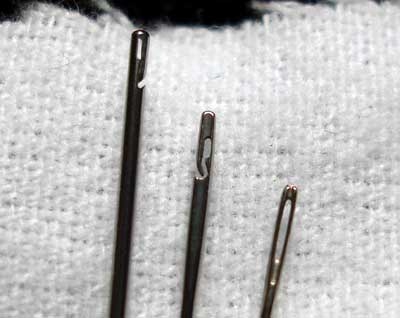
From left to right, you can see the SE1 (sharp, size 4), the SE2 (embroidery, size 6) and a regular size 7 crewel needle (Richard Hemming, I believe…)
The Spiral Eye needles are significantly larger, overall, than a regular embroidery needle:
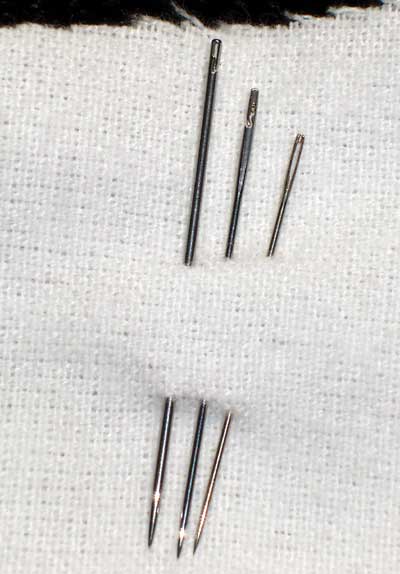
You can see there the size of the needle shafts. The shafts are made from surgical quality stainless steel, unplated. The advantage to the unplated stainless steel is that you can sharpen them and they clean up well, so you don’t have to pitch them when they’ve been over-used! Also, on the website for the Sprial Eye needle, they point out that most needles are coated with nickel, which some people are allergic to, so the stainless steel needle eliminates the question of nickel allergies.
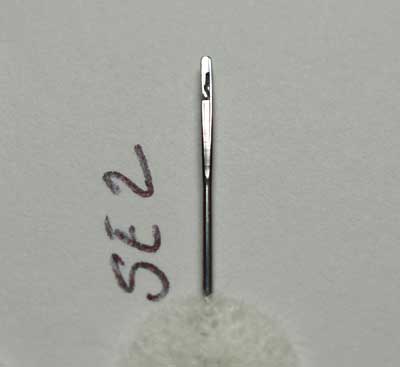
This is the SE2, upclose. I didn’t experiment with this particular needle, due to some problems with the manufacturing which have since been worked out.
I tested and worked with the SE1 quite a bit, though.
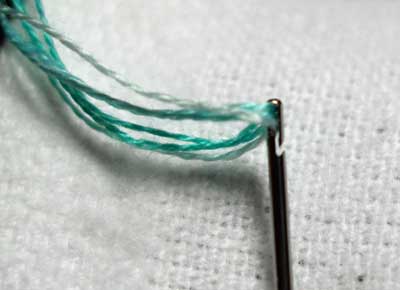
It holds up to three strands of DMC cotton. It’s super-easy to thread the needle – you just pinch the thread and slide it up the shaft and it pops right into the eye. If you’re working with several strands of stranded cotton at a time, you have to thread each strand individually. All three together are too thick for the side opening on the needle. It doesn’t take any time at all, really. They just slide right in.
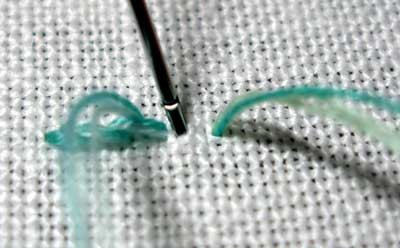
This is a stitch in process here. I half-way expected the needle to catch on the fabric on the way back up, but it doesn’t. It passes through the fabric very easily.
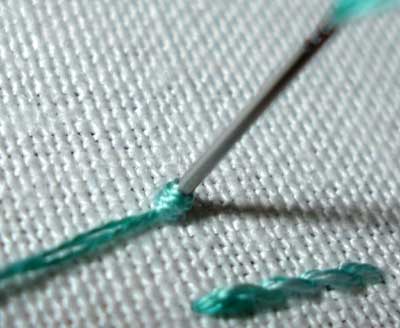
It occurred to me that an needle with an opening on the side might cause some difficulty with stitches like French knots, so I set about testing it with some of those.
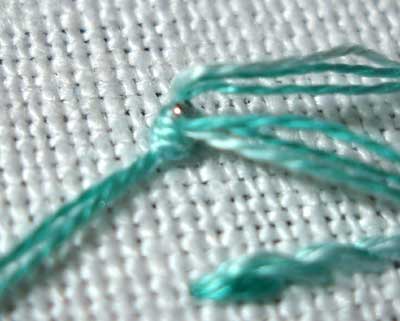
It pulled through easily, without any hang-ups…
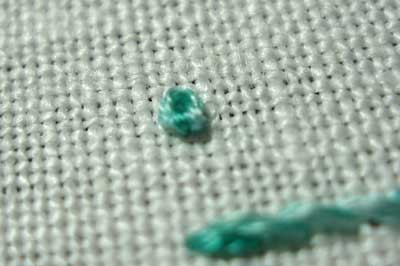
…resulting in nice French knots.
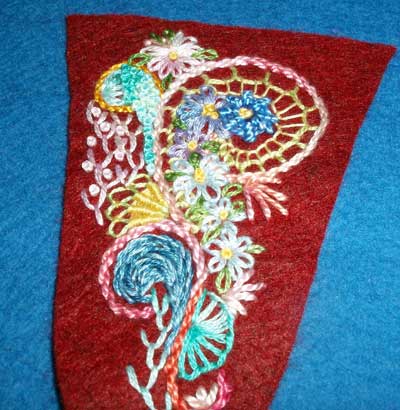
Next, I put the needle to work on a little piece of felt, thinking a fuzzy fabric might cause a problem. But it worked just fine!
Spiral Eye Needles in Summary
1. The little difficulties I experienced with both SE2 needles were straightened out since this article was first printed.
2. The SE1 is great for stitching with stranded cotton, up to three strands.
3. They really are easy to thread, and the thread does not come unthreaded like the calyx eye (top threading) needles do.
4. But, if you’re using more than one strand of floss, you have to thread each strand individually.
5. But it doesn’t take any time to do so – and if your strip your floss, anyway, I don’t think this is any big deal.
6. The real advantage to these needles, I think, is for people who have a hard time threading regular needles because of eye sight problems or arthritis. The website suggests their use for children, which I suppose could be true, too, but I find, with teaching children, that heavier threads are better to use, and these needles won’t accommodate heavier threads.
7. No, they won’t work for heavier threads, such as crewel wool or even pearl cotton #12. They’re great with any sewing or even heavy quilting thread, and they work great with one strand of DMC threaded at a time. But the heavier threads won’t fit in the side opening. So, in this sense, they have a limited use.
I like the feel of the needles – they’re smooth and tough. They’re absolutely strong – bending them with your fingers is almost out of the question. It’s quite obvious that they’re made out of high quality material, with attention to detail, and made to last.
If you’re looking for a Spiral Eye needle – a needle that’s easy to thread and well-made – check out the Spiral Eye Needles website, where you can get the low-down on the company and their products.
While you’re there, note their little motto: “A stitch in time saves nine … but you still have to thread the needle!” Funny!
If you’ve tried these needles – or other “non-threading” needles (like the calyx needles) – please do let the rest of us know your thoughts about them! I’d like to hear what others have to say.







WOW! I loved this little review you did. I had no idea they had needles like this and am def going to have to go about finding one online. Thanks so much for the review. I love your work and your site as well.
Thank you for the wonderful write up about my needles. I am currently working on several sizes and hope to have them all perfected by the end of November, including a size 10 quilting needle. With each size we run into a few glitches and apprecaiate all feedback so we can make my Spiral Eye Needles the best they can possibly be. e have taken care of the comments you made about the SE-2 and have them available now on the site. Thank you again. Pam Turner, inventor of the Spiral Eye Needle.
I need to see if I can get my hands on a couple of these. I don’t usually have problems threading needles, but sometimes it’s tricky when your thread is getting a wee bit too short and you really want to squeak out the last little bit. These look like they might be a sneaky solution to that!
I love the article about the Spiral Eye Needles. Of course. I am the inventor so I would. But it is now 2012 and my invention has grown and improved with age. I now carry many many sizes and types of needles and even have a needle for sewing machines. Thank you for the attention your article has and continues to give my product.
I recently tried my new set of spiral eye needles – size 8, 6 and 4, while doing the hand work on a quilt binding. I love the way it threads and I love the fact that they are made in the U.S.A. I don’t love the fact that all 3 sizes shredded my thread. Sizes 8 and 6 were the worst, but even the size 4 eventually did it also. I was using Gutermann polyester thread, I believe 50 wt. I would appreciate receiving a new set of needles that didn’t shred thread.
Mary thank you for this topic today. I just read about the spiral needles. I wrote you a few times about being visually impaired and needles is something I have problems with. I do wish the spiral needles could use pearl cotton which is what I am using a lot for several different things. I enjoy your blog and read it close to every day.
The first I have heard of this needle. Definitely not available in South Africa
I have used the spiral eye needles and really like them. It didn’t occur to me to just do “regular” stitching with them (thanks, Mary). I use them for burying threads when I am done quilting a quilt and you have two or four short threads that you need to take to the inside of your quilt sandwich. They don’t shred the thread the way the “ladder” type easy threading needles sometimes do for me, and the thread doesn’t pull out the top if you have to tug a bit to get a knot to pop through to the inside of a quilt sandwich.
I loved reading your most interesting topic about needles. thank you for sharing.